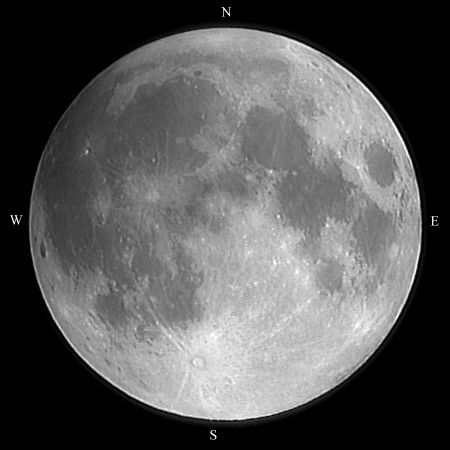

Some confusion can arise from the orientation of astronomical images, and especially with the definition of east and west. Astronomy developed in the northern hemisphere, so orientations are all written as seen by observers in the north. Observers in the southern hemisphere see the sky upside down. A few years ago my daughter visited New Zealand and she remarked that she was surprised to see Orion upside down. I pointed out to her that it was she who was upside down, not Orion.
For north-south there is little difficulty. North is in the direction of the Earth's north, so for example Polaris, the pole star, is near the north celestial pole. The confusion results from the old convention of showing images with south at the top. This arose because most observers were in the northern hemisphere and astronomical telescopes turn the image upside down, so these pictures showed the object as it appeared in the telescope. For example Hatfield's Photographic Lunar Atlas presents all his pictures with south at the top. This makes it much easier to trace your way on the Moon using his photographs when looking into an eyepiece. However, perhaps with the advent of the space age, it became common to present images with north at the top (like on Earth). This is now the official convention, but of course older pictures will still be with south at the top.
East-west has given rise to similar confusion. Traditionally astronomers would refer to these directions in the sky as corresponding with the equivalent direction on Earth. This meant that when looking at the Moon, for example, north was at the top (at least for observers in the northern hemisphere) and east was on the left. So Mare Orientale, the Eastern Sea, is on the left of the Moon when looking south. The same applied to the Sun. This resulted in a strange anomaly. The Earth, the Moon, the Sun, and almost all the planets rotate in the same direction (anti-clockwise as seen from above the north pole). The Earth rotates west to east, but the old convention meant that the Sun and the Moon (and presumably all the other planets too) rotated east to west.
The convention now is that by definition all bodies rotate west to east. So if you were standing on any body in the solar system you would see the Sun rise in the east and set in the west. (In fact this was implicit for Mars, where many authors would point out that if you were on the surface of Mars, then Phobos would rise in the west and set in the east because of its very short orbital period of less than the Martian day.) North remains, I believe, as it has always been, so on most bodies the points of the compass are the same as they are on Earth. The major exception seems to be Venus, which rotates retrograde (the opposite way to the Earth). This means that if you were standing on Venus facing north then west would be on your right. (Fortunately, perhaps, it is likely to be a very long time before anyone has to face this anomaly.) What it means on Uranus, I hate to think. Some authors quote the axial tilt as >90 degrees, meaning that the north pole points slightly south. I am not clear which way up the Voyager pictures are normally printed. I suspect with it rotating left to right. What that means I leave as an exercise for the reader.... The convention also means that Mare Orientale on the Moon is now in the west.
Throughout this web site I have tried to keep to the modern convention. Pictures should all be with north at the top and west to the left.
